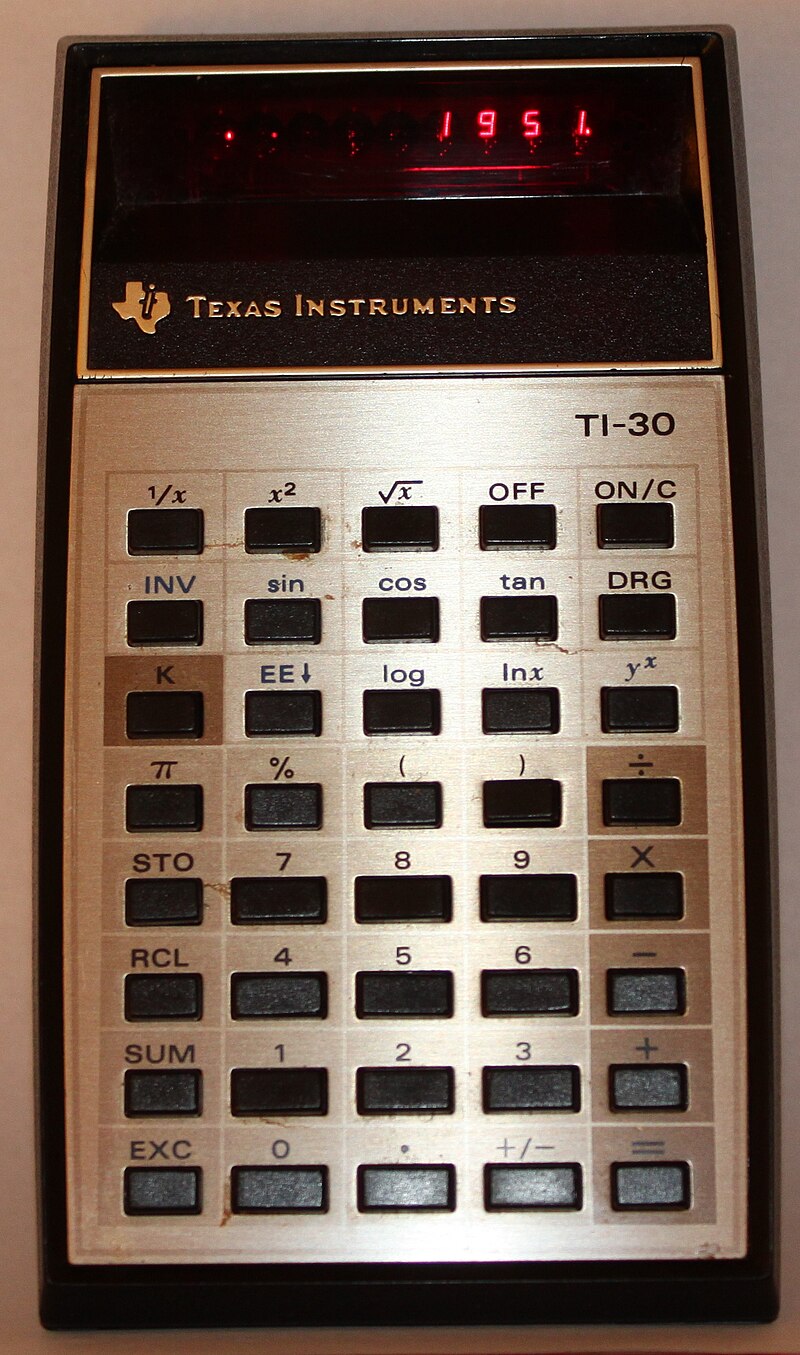Texas Instruments revolutionized education when it launched its first own-brand handheld calculator in 1972. You’ve likely used their iconic TI-84 Plus in math class, a device whose core interface has stayed familiar even as the hardware evolved. Through strategic partnerships with schools, textbook publishers, and standardized-testing boards, TI secured classroom dominance. Retail prices often land around $100+, while production costs are undisclosed (outside estimates vary), helping the business remain highly profitable. The story behind this classroom near-standard reveals much more than just smart business.
Image: Texas Instruments, TI signboard Dallas, CC BY 3.0
The Birth of Handheld Computing: TI’s Early Calculator Revolution
Innovation sparked a revolution in 1966 when Texas Instruments began developing what became the “Cal-Tech” pocket-calculator prototype. Under Jack Kilby’s leadership, the project aimed to create a book-sized computing device that would fit in your hand.
By 1967, TI engineers had a working prototype using TI’s integrated circuits, with roughly 18 keys and a 12-digit display powered by rechargeable batteries. (That prototype—foundational to the first commercial units sold by other brands—now resides in major museum collections.)
The cultural significance became evident when TI’s own TI-2500 “Datamath” debuted in 1972 at $149.95. This milestone brought handheld calculation to the mass market and cemented TI as a force in consumer electronics. Kilby’s pioneering work on the integrated circuit later earned him the 2000 Nobel Prize in Physics, reinforcing TI’s reputation for breakthrough technology.
From Basic Math to Graphing: The Evolution of TI Calculator Technology

The success of the Datamath was only the beginning. By 1974, the SR-50 pushed beyond basic arithmetic with trigonometric and logarithmic functions, while early programmability let users store custom sequences.
Classroom-focused models followed (e.g., TI-12 Math Explorer for elementary use), and communities flourished around TI-BASIC and assembly programming. TI advanced power options through the TI-1766 in 1981—TI’s first solar-powered handheld (industry-wide solar models had appeared earlier).
Graphing arrived even earlier than many remember: TI’s first graphing model, the TI-81, launched in 1990. Later hits like the TI-83 family used Z80 processors, and successive TI-84 generations moved to faster chips—ultimately ARM-based systems with color displays (e.g., TI-84 Plus C SE in 2013 and TI-84 Plus CE in 2015).
Strategic Educational Partnerships: How TI Became a Classroom Staple
Hardware alone didn’t win classrooms. TI built a complete educational ecosystem around its devices. The T³ (Teachers Teaching with Technology) program, begun in 1988, grew into a professional-development engine training tens of thousands of teachers worldwide.
TI paired PD with curriculum materials, loaner programs, and university collaborations, aligning products to standards and tests so implementation felt seamless. By working closely with textbook publishers and testing bodies, TI positioned its calculators as the default choice in U.S. math classrooms—an approach that helped the company command roughly 80% of the U.S. graphing calculator market for years.
The TI-84 Plus Phenomenon: Anatomy of an Educational Icon
Few tools have shaped modern math instruction like the TI-84 Plus line. Compared to its TI-83 predecessors, the TI-84 platform offered ~2.5× the clock speed and significantly more memory, yet preserved a familiar key layout so teachers and students could adopt it quickly. Many schools buy School Property editions in yellow shells, and USB connectivity enables data transfer and classroom activities.
The TI-84 ecosystem supports statistics, regression, and multiple graph types—helping students visualize abstract ideas rather than only memorize formulas. Its wide acceptance on standardized tests and ongoing OS updates have kept the TI-84 family relevant across generations.
Unlike the roller coasters at Six Flags Fiesta Texas that provide thrilling experiences, the calculator offers intellectual stimulation through mathematical exploration. Teacher packs include 10 calculators bundled together, making classroom implementation efficient and cost-effective.
Standardized Testing’s Role in Calculator Adoption
Calculator policy changed dramatically when the College Board allowed calculators on the SAT beginning in 1994. Usage surged within a few years, and calculators became classroom essentials. TI aligned models with exam requirements and training so educators could rely on approved devices.
The result: a strong feedback loop where testing policies, teacher familiarity, and publisher content reinforced TI’s position.
The Educational Ecosystem: Textbooks, Teachers, and TI Integration
TI’s dominance extends into textbooks and teacher support. Major publishers built TI-specific examples and activities into their programs, while T³ workshops raised teacher confidence with hands-on practice. Partnerships with organizations such as NCTM and the College Board helped ensure TI models matched curricular goals and exam rules.
The outcome is not just a device, but a turnkey classroom solution that makes switching costlier for schools.
Pricing and Profit: The Business Model Behind Educational Technology
TI’s calculator business is notable for premium retail pricing in a mature category. While a TI-84 Plus often retails around $100+, TI does not disclose unit manufacturing costs; third-party estimates vary and can understate broader expenses like R&D, software, support, and educator training.
Still, the ecosystem lock-in—curricula, testing approval, pro-development, and installed base—helps sustain pricing power far longer than typical consumer electronics.
Competitors and Challenges to TI’s Market Dominance
Competition remains real. Casio (e.g., fx-9750GIII, fx-CG50) and HP (e.g., HP Prime) offer capable graphing options, while NumWorks pursues an open, student-friendly approach. The bigger long-term challenge is software alternatives (e.g., Desmos) and tablets—though many testing policies still limit smartphones and touch-first apps.
TI’s task is to keep classroom advantages while responding to digital expectations and tighter school budgets.
The Debate Over Calculator Dependency in Mathematics Education
Decades on, educators still debate calculators’ impact. Evidence shows graphing calculators can reduce procedural load and shift focus to higher-order problem solving, yet overreliance may blunt arithmetic fluency if fundamentals aren’t taught intentionally.
Many teachers adopt scaffolded policies—early emphasis on mental/math facts, followed by structured calculator use for modeling, data analysis, and complex exploration.
Legacy and Lessons: What TI’s Success Teaches About EdTech Adoption
TI’s story shows that lasting EdTech adoption hinges on ecosystems, not gadgets. The winning formula combined teacher PD, standards alignment, publisher integration, testing approvals, and ongoing support. That framework created a de facto standard that outlived multiple tech cycles.
For EdTech companies, the lesson is clear: build tools and the instructional scaffolding that makes them easy to teach, assess, and trust.


